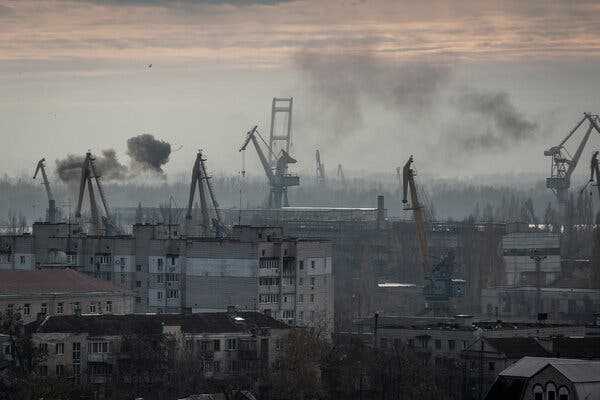Weapons investigators in Kyiv found that at least one Russian Kh-101 cruise missile used in widespread attacks there on Nov. 23 had been made no earlier than October.
-
Send any friend a story
As a subscriber, you have “>10 gift articles to give each month. Anyone can read what you share.
Give this articleGive this articleGive this article
- +

Russia attacked the port of the southern Ukrainian city of Kherson in November.
Some of the cruise missiles that Russia launched at Ukraine’s civilian infrastructure in late November were manufactured months after the West imposed sanctions intended to deprive Moscow of the components needed to make those munitions, according to a weapons research group.
Experts examined remnants of Kh-101 cruise missiles found in Kyiv, the capital, after an attack on Nov. 23 that knocked out electricity and shut down water systems in large areas of the country. One of the missiles was made this summer, and another was completed after September, markings on the weapons show, according to a report released by the investigators on Monday.
That Russia has continued to make advanced guided missiles like the Kh-101 suggests that it has found ways to acquire semiconductors and other matériel despite the sanctions or that it had significant stockpiles of the components before the war began, one of the researchers said.
The findings are among the most recent by Conflict Armament Research, an independent group based in Britain that identifies and tracks weapons and ammunition used in wars. A small team of its researchers arrived in Kyiv just before the attack at the invitation of the Ukrainian security service.
In four previous research trips to Kyiv since the invasion, the investigators found that almost all of the advanced Russian military gear they examined — like encrypted radios and laser range finders — was built with Western semiconductors.
The State of the War
- Russian Oil Price Cap: The E.U. agreed on a $60-a-barrel limit for Russian oil, the latest effort by Western allies to try to deprive Moscow of revenue to finance its war in Ukraine. Here’s how it will work.
- A Pivotal Point: Ukraine is on the offensive, but with about one-fifth of its territory still occupied by Russian forces, there is still a long way to go — and the onset of winter will bring new difficulties.
- Ukraine’s Power Grid: As many Ukrainians head into winter without power or water, crews are racing to restore Ukraine’s battered energy infrastructure, but Russian airstrikes threaten to undo such efforts.
The investigators were unable to determine whether the Kh-101 remnants they studied were from missiles that reached their targets and exploded or were intercepted in flight and shot down.
The Kh-101 missiles were marked with a 13-digit numerical sequence. The investigators said they believe that the first three digits represent the factory where the missile was made, followed by another three-digit code indicating which of two known versions of the Kh-101 it is and two digits indicating when it was manufactured. A final string of five numbers is believed to denote the missile’s production batch and serial number.
Piotr Butowski, a Polish journalist who has written extensively about Russia’s warplanes and military munitions, said the group’s numerical analysis matched up with his research.
“The first three digits are always ‘315’ — this is the production facility code,” Mr. Butowski said in an email. “Kh-101 missiles are developed and manufactured by the Raduga company in Dubna near Moscow.”
In an interview before the report was released, a U.S. defense intelligence analyst said that Mr. Butowski’s analysis was consistent with the government’s understanding of how Russian missile producers — including those that make the Kh-101 — mark their weapons. The official, who was not authorized to speak publicly, said Russia was generally believed to be experiencing ammunition stockpile problems and may be using newer munitions alongside those that are much older.
The analyst said that reports from Russia indicate that the government has ordered employees at munition plants to work additional hours in an effort to produce more ordnance, and that it is clear that Russia is now firing fewer long-range weapons like cruise missiles at a smaller number of targets in Ukraine.
Pentagon officials say Russia has fired thousands of long-range weapons like cruise missiles as well as short- and medium-range ballistic missiles at targets in Ukraine since the war began.
Whether Russia has depleted its inventory of older cruise missiles is unclear. But militaries often use older munitions first in combat because they typically make up a majority of a nation’s stockpile.
On Nov. 23, the same day as the cruise missile attack on Kyiv, Lloyd J. Austin III, the secretary of defense, told reporters that Russia’s supply of precision-guided weapons had been “significantly reduced” and that it would be more difficult for Russia to rapidly produce them “because of the trade restrictions they have on microchips and other types of things.”
But Damien Spleeters, who led Conflict Armament Research’s investigation, said it would be difficult to say that the Russians are running short on weapons.
“Those claims have been made since April,” he said, “so we’re just pointing to the fact that these cruise missiles being made so recently may be a symptom of that, but it’s not a certainty.”
Source: nytimes.com



